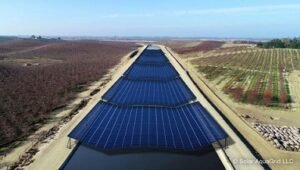Continuously shaping the future of sustainable power generation, renewable energy innovations pave the way for cleaner energy solutions. Moreover, here, we delve into five smart solutions revolutionizing the field, each promising significant advancements in harnessing clean energy sources.
Amidst the world’s growing urgency to mitigate climate change and shift towards sustainable energy sources, the pursuit of innovative renewable energy solutions has become increasingly vital. In this comprehensive introduction, we embark on an exploration of five groundbreaking innovations poised to redefine the renewable energy sector.These advancements not only promise to revolutionize the way we harness energy from natural resources but also hold the potential to address key challenges such as energy intermittency, storage limitations, and scalability. Through an in-depth examination of these innovations, we will uncover the transformative potential they offer in driving the global transition towards a cleaner, more resilient, and sustainable energy future.
Report Overview
The World Economic Forum’s report underscores the sluggish progress in the global energy transition over the past three years and underscores the urgent imperative for renewable energy innovation to combat climate change.
Importance of Renewable Energy Innovation
Addressing climate goals requires fast and effective renewable energy innovation to mitigate greenhouse gas emissions.
Importance of Renewable Energy Innovation
Renewable energy innovation stands as a pivotal aspect in addressing the pressing global challenges posed by climate change, energy security, and sustainability. As the world moves towards a low-carbon future, the significance of advancing renewable energy technologies cannot be overstated. Here’s an exploration of why renewable energy innovation is of paramount importance:
Mitigating Climate Change With Renewable Energy Sources
Reducing Greenhouse Gas Emissions
Renewable energy sources such as solar, wind, hydro, and geothermal power offer clean alternatives to fossil fuels, which are the primary drivers of greenhouse gas emissions. By transitioning to energy sources, we can significantly mitigate the emissions responsible for climate change, thereby curbing global warming and its associated impacts.
Meeting Climate Targets
In order to meet ambitious climate targets outlined in international agreements such as the Paris Agreement, innovations in renewable energy technologies are essential. These objectives require rapid decarbonization of the energy sector, a goal that can only be achieved through scalable and efficient renewable energy solutions.
Enhancing Energy Security
Diversifying Renewable Energy Sources
Relying on finite fossil fuel reserves exposes nations to geopolitical risks and price volatility. However, renewable energy innovation facilitates the diversification of energy sources, thereby reducing dependence on imported fossil fuels. By harnessing abundant, domestically available renewable resources, it enhances energy security.
Resilience to Disruptions
Renewable energy systems, characterized by distributed generation and modular infrastructure, provide resilience to disruptions caused by natural disasters, cyberattacks, or geopolitical conflicts. Consequently, by decentralizing energy production, communities can better withstand and recover from disruptions, ensuring uninterrupted access to electricity.
Promoting Economic Growth and Job Creation
Stimulating Innovation and Investment
Investments in renewable energy innovation propel technological advancements, leading to cost reductions and efficiency improvements throughout the renewable energy sector. Consequently, this nurtures innovation ecosystems, stimulating economic growth, fostering the creation of high-quality jobs, and catalyzing sustainable development.
Fostering Energy Independence
By harnessing indigenous sustainable resources, countries can diminish their dependence on imported energy sources, thereby enhancing energy independence and decreasing trade deficits. Consequently, this transition towards locally sourced renewable energy fosters economic resilience and fortifies national energy security.
Improving Public Health and Environmental Quality by using Renewable Energy Sources
- Mitigating Air and Water Pollution
By substituting fossil fuel combustion with clean renewable energy sources, air and water pollution can be reduced, thus mitigating health risks linked to respiratory diseases, cardiovascular ailments, and water contamination.
Renewable energy innovation thus contributes to improving public health and environmental quality, particularly in urban areas.
- Preserving Ecosystems and Biodiversity
Renewable energy technologies have lower environmental impacts compared to fossil fuel extraction and combustion, thereby mitigating habitat destruction, land degradation, and biodiversity loss. Protecting ecosystems and preserving biodiversity is essential for ensuring the long-term sustainability of the planet.
Five Solutions for Meeting Emissions Targets to Accelerate Renewable Energy Transition:
Here are five innovative solutions that could help countries meet emissions targets and accelerate the transition to sustainable energy:
Solar and Wind Power Integration
French start-up Unéole introduces a small-scale, easy-to-install solution that combines solar and wind power in a single unit.
Benefits
- Designed for flat roofs of buildings.
- Utilizes multiple wind turbines under a photovoltaic roof.
- Produces 40% more energy than pure solar systems.
- Operates round the clock.
Turbine-less Wind Power
A US start-up pioneers a system using three-meter tall wind generators with no external moving parts, known as Aeromine.
Benefits
- Utilizes natural airflow up the front of buildings.
- Employs aerodynamic fins to guide fast-rising air past internal turbines.
- Claims to produce 50% more power than other sustainable options.
- Combined with rooftop solar and battery storage, can meet 100% of a building’s energy needs.
Solar Canals

Solar Aqua Grid in California proposes roofing over the state’s canals with solar panels to generate power and reduce evaporation.
Benefits
- A solution to water scarcity and droughts.
- Forecasted to save 283 billion litres of water annually.
- Expected to generate power for 9.4 million homes.
Solar Power Windows

Ubiquitous Technology in California develops transparent solar panels that can be integrated into windows.
Benefits
- Allows visible light to pass through while converting ultraviolet and infrared light into electricity.
- Can generate up to 30% of a building’s power needs.
Atmospheric Water Generation
US start-up Source creates off-grid “hydro panels” that extract water vapor from the air and convert it into liquid water.
Benefits
- Addresses water scarcity issues.
- Eliminates the need for single-use plastic water bottles.
- Installed in 50 countries, providing water in hard-to-reach areas.

1 thought on “5 Smart Renewable Energy Innovations”